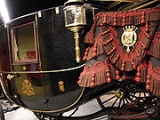
Mossman Collection
Encyclopedia
The Mossman Carriage Collection is a museum housing a collection of horse-drawn vehicle
s in Stockwood Park
, Luton
, Bedfordshire
. It is the largest collection of such vehicles in the United Kingdom, and includes original vehicles dating from the 18th, 19th and 20th centuries.
dating from Roman
times up until the 1930s. The collection has examples of vehicles used by tradesmen and ordinary people as well as luxury vehicles and state coaches used by the British nobility and on the large British estates.
The collection is significant to the people of Luton, Bedfordshire as it documents the life’s work and passions of a local man. It is also of national significance as the largest private collection of horse-drawn vehicles.
Mossman had a varied working life, running several businesses and a farm. He acquired a leasing company providing horse-drawn carriages for special events such as weddings, carnivals and public occasions. Mossman drove his carriages in London’s Lord Mayor's Show for 25 years and provided some carriages and drivers for Queen Elizabeth's coronation procession in 1953.
 The museum houses 54 registered vehicles of Mossman's, as well as carriages from the Luton Museum Services collection. In total there are more than 63 vehicles on display, including original carriages from the 18th to the 20th centuries as well as replicas made for Mossman's work with Pinewood and Elstree firm studios in the latter part of the 20th century.
The museum houses 54 registered vehicles of Mossman's, as well as carriages from the Luton Museum Services collection. In total there are more than 63 vehicles on display, including original carriages from the 18th to the 20th centuries as well as replicas made for Mossman's work with Pinewood and Elstree firm studios in the latter part of the 20th century.
Unusual vehicles include an 18th-century landau
and an early-19th-century barouche
, both in very good condition. There is also an 1890s 'char-a-bang'
which dates from the early days of public transportation.
Horse-drawn vehicle
A horse-drawn vehicle is a mechanized piece of equipment pulled by one horse or by a team of horses. These vehicles typically had two or four wheels and were used to carry passengers and/or a load...
s in Stockwood Park
Stockwood Park
Stockwood Park is a large urban park in Luton, Bedfordshire, in the Farley Hill estate. With period formal gardens, leading crafts museums and extensive golfing facilities, it is about 100 hectares in area...
, Luton
Luton
Luton is a large town and unitary authority of Bedfordshire, England, 30 miles north of London. Luton and its near neighbours, Dunstable and Houghton Regis, form the Luton/Dunstable Urban Area with a population of about 250,000....
, Bedfordshire
Bedfordshire
Bedfordshire is a ceremonial county of historic origin in England that forms part of the East of England region.It borders Cambridgeshire to the north-east, Northamptonshire to the north, Buckinghamshire to the west and Hertfordshire to the south-east....
. It is the largest collection of such vehicles in the United Kingdom, and includes original vehicles dating from the 18th, 19th and 20th centuries.
About
The collection was donated to the Luton Museum Service in 1991 (now Stockwood Discovery Centre part of Luton Culture) and has examples of horse-drawn road vehicles and carrages used in BritainGreat Britain
Great Britain or Britain is an island situated to the northwest of Continental Europe. It is the ninth largest island in the world, and the largest European island, as well as the largest of the British Isles...
dating from Roman
Ancient Rome
Ancient Rome was a thriving civilization that grew on the Italian Peninsula as early as the 8th century BC. Located along the Mediterranean Sea and centered on the city of Rome, it expanded to one of the largest empires in the ancient world....
times up until the 1930s. The collection has examples of vehicles used by tradesmen and ordinary people as well as luxury vehicles and state coaches used by the British nobility and on the large British estates.
The collection is significant to the people of Luton, Bedfordshire as it documents the life’s work and passions of a local man. It is also of national significance as the largest private collection of horse-drawn vehicles.
History
The collection was put together by George Mossman who was born in Luton in 1908. Shortly after the First World War, Mossman left school and started work for a local butcher, Panters, in Park Street, as a delivery driver. This was the beginning of Mossman's lifelong interest in horse-drawn transport.Mossman had a varied working life, running several businesses and a farm. He acquired a leasing company providing horse-drawn carriages for special events such as weddings, carnivals and public occasions. Mossman drove his carriages in London’s Lord Mayor's Show for 25 years and provided some carriages and drivers for Queen Elizabeth's coronation procession in 1953.

Unusual vehicles include an 18th-century landau
Landau
Landau or Landau in der Pfalz is an autonomous city surrounded by the Südliche Weinstraße district of southern Rhineland-Palatinate, Germany. It is a university town , a long-standing cultural centre, and a market and shopping town, surrounded by vineyards and wine-growing villages of the...
and an early-19th-century barouche
Barouche
A barouche was a fashionable type of horse-drawn carriage in the 19th century. Developed from the calash of the 18th century, it was a four-wheeled, shallow vehicle with two double seats inside, arranged vis-à-vis, so that the sitters on the front seat faced those on the back seat...
, both in very good condition. There is also an 1890s 'char-a-bang'
Charabanc
A charabanc or "char-à-banc" is a type of horse-drawn vehicle or early motor coach, usually open-topped, common in Britain during the early part of the 20th century. It was especially popular for sight-seeing or "works outings" to the country or the seaside, organised by businesses once a year...
which dates from the early days of public transportation.

